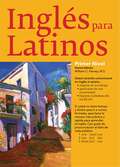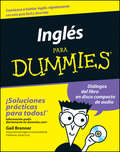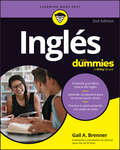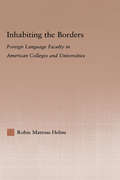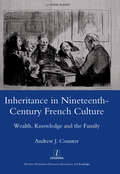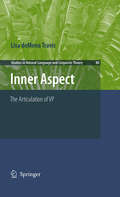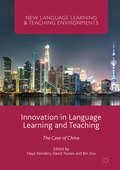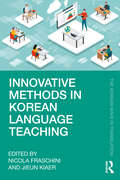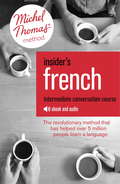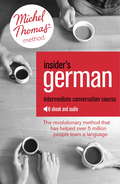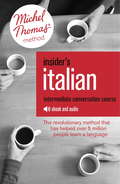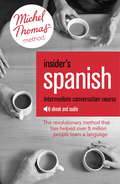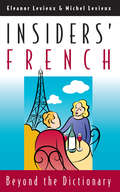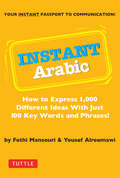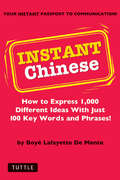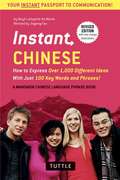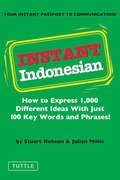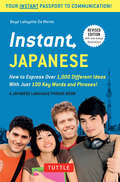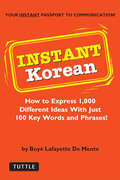- Table View
- List View
Ingles Para Latinos-Level 1, 4th edition
by William C. HarveyINGLES PARA LATINOS LEVEL 1 is designed to teach Hispanics in the United States and Canada a practical working knowledge of English. Updated with additional commonly-used phrases, new questions and answers for practice and review, and listening aids such as find-the-word boxes, jumbled words, and crosswords, the new edition of this informal language-learning program has been created to give Hispanics in the United States and Canada a practical working knowledge of English. Author William Harvey bypasses the dull rules of grammar, and instead familiarizes readers with often-used phrases, including a series of informal conversations among speakers in idiomatic American English. It also features tables that present commonly-used English verbs and verb tenses. Emphasis on correct pronunciation includes helpful tips and advice on pronunciation and listening comprehension. The supplemental downloadable audio uses spoken dialogues and coaching to emphasize correct pronunciation of informal American English.
Inglés Para Dummies
by Gail BrennerLa guía más efectiva de inglés básico para hablantes nativos de español Ingles Para Dummies es una guía para aprender lo más básico del idioma inglés.Esto le ayudara a ponerse al día con lecciones prácticas, ilustraciones útiles, y con una gran cantidad de ejemplos. Usted puede estudiar desde casa a su propio ritmo, es decir, la combinación perfecta. Escrito por un líder experto en del idioma inglés Lleno de tablas útiles para aprender vocabulario Ofrece sugerencias y consejos para descifrar el código de la gramática del ingles El audio disco compacto contiene conversaciones que enseñan la pronunciación correcta Este libro y disco compacto ofrecen cobertura de todo los aspectos esenciales del idioma ingles incluyendo gramática, su uso, y vocabulario que le permitira hablar inglés en al instante. ENGLISH DESCRIPTION The most effective guide to basic English for native Spanish Speakers Ingles Para Dummies is your guide for learning the basics of the English language. It will help to get you up to speed with practical lessons, helpful illustrations, and a wealth of examples. You can to study at home and at your own pace—the perfect combination. Written by a leading English language expert Filled with helpful charts for learning vocabulary Offers suggestions and tips for cracking the code of English grammar he audio CD demonstrates conversations presented and illustrates correct pronunciation This book and companion CD offers coverage of all English language essentials including grammar, usage, and vocabulary that will have you speaking English in no time. Note: CD-ROM/DVD and other supplementary materials are not included as part of eBook file.
Inglés Para Dummies
by Gail BrennerEs fácil aprender inglés, lo prometemos Ingles Para Dummies está repleto de explicaciones claras de la gramática, el uso, la jerga y más en inglés, todo en un formato fácil de seguir. Estudia a su propio ritmo, en la comodidad de su hogar, con esta guía imprescindible para cualquier persona que quiera aprender inglés. Le encantará el útil mini diccionario inglés-español mientras aprende la jerga para saludos personales, conversaciones telefónicas, compras, viajes, cenas y otras actividades diarias. Además, los ejemplos del mundo real te permiten poner en práctica sus nuevas habilidades. Con ayuda de pronunciación, consejos y trucos, y errores comunes para evitar, Ingles Para Dummies tiene todo lo que necesitas para usar el inglés con confianza. Aprende la gramática básica del inglés y las expresiones importantes del día a día Practica tu pronunciación y evita errores comunes Domina frases útiles para el hogar, el trabajo, la salud y la recreación Usa atajos prácticos y jerga auténtica para una conversación fácil y divertidaLos hispanohablantes que recién comienzan con el inglés pueden aprender rápida y fácilmente vocabulario básico, gramática y habilidades de conversación, además de mejorar la confianza para hablar y manejar situaciones cotidianas, gracias a este divertido libro Dummies.
Inhabiting the Borders: Foreign Language Faculty in American Colleges and Universities (Studies in Higher Education)
by Robin Matross HelmsThis book focuses on the experience of foreign language faculty in American colleges and universities, the challenges they face, and ways that academia can better support language faculty, and marginalized faculty in other fields, in their important work.
Inheritance and Innovation in a Colonial Language
by William Jennings Stefan PfänderThis book takes a fresh approach to analysing how new languages are created, combining in-depth colonial history and empirical, usage-based linguistics. Focusing on a rarely studied language, the authors employ this dual methodology to reconstruct how multilingual individuals drew on their perception of Romance and West African languages to form French Guianese Creole. In doing so, they facilitate the application of a usage-based approach to language while simultaneously contributing significantly to the debate on creole origins. This innovative volume is sure to appeal to students and scholars of language history, creolisation and languages in contact. Chapter 3 is published open access under a CC BY 4. 0 license.
Inheritance in Nineteenth-century French Culture: Wealth, Knowledge and the Family
by AndrewJ. CounterThe transmission of wealth between generations was not only a narrative commonplace in nineteenth-century France, but also a topic of considerable cultural anxiety and intense political debate. In this study, Andrew J. Counter draws on a wealth of previously unexplored material to show how the theme of inheritance in literature and beyond acquired ethical, historical and ideological connotations, and was vital to nineteenth-century French conceptions of the family and of the legacy of the Revolution. Weaving together fiction, drama, legal texts, historiographical thought and political writing, Inheritance in Nineteenth-Century French Culture teases out a complex leitmotiv that gives us a new understanding of nineteenth- century Frances sense of its own place in history. It also proposes innovative readings of writers as familiar as Honore de Balzac, George Sand, Guy de Maupassant and Emile Zola, while drawing attention to a range of neglected authors and works.
Inner Aspect
by Lisa Demena TravisThis monograph probes the structure of the verb phrase through a cross-linguistic investigation of the syntax and morphology of relevant constructions. Evidence is provided for two event-related non-lexical projections called "inner aspect" and "event".
Innovating the TESOL Practicum in Teacher Education: Design, Implementation, and Pedagogy in an Era of Change (Routledge Research in Language Education)
by Chang PuRecognizing new opportunities and challenges brought about by technological and social change, as well as the COVID-19 pandemic, this volume explores innovative design, implementation, and pedagogy for practica experiences in teacher education programs in the field of Teaching English to Speakers of Other Languages. By showcasing research and practice undertaken in a range of teacher education courses and programs, the volume offers evidence-based approaches to enhancing pre- and in-service teachers’ learning and cultural awareness. Chapters come together coherently to address issues and explore innovative structures revolving around high-quality TESOL practica. Particular attention is paid to emerging opportunities offered by virtual and simulated learning in online and in-person practica, as well as potential changes to best practice in community-based programs. Using a diverse set of lenses to examine the practical, theoretical, and methodological aspects of TESOL practica, this volume will be of interest to students, scholars and researchers with an interest in TESOL education, as well as in open and distance education.
Innovation and change in English language education
by Ken Hyland Lillian L. C. WongQuestions about what to teach and how best to teach it are what drive professional practice in the English language classroom. Innovation and change in English language education addresses these key questions so that teachers are able to understand and manage change to organise teaching and learning more effectively. The book provides an accessible introduction to current theory and research in innovation and change in ELT and shows how these understandings have been applied to the practical concerns of the curriculum and the classroom. In specially commissioned chapters written by experts in the field, the volume sets out the key issues in innovation and change and shows how these relate to actual practice offers a guide to innovation and change in key areas grounded in research relates theory to practice through the use of illustrative case studies and examples brings together the very best scholarship in TESOL and language education from around the world This book will be of interest to upper undergraduate and graduate students in applied linguistics, language education and TESOL as well as pre-service and in-service teachers, teacher educators, researchers and administrators keen to create and manage teaching and learning more effectively.
Innovation in Language Learning and Teaching
by David Nunan Hayo Reinders Bin ZouThis book investigates the ways in which new developments in areas of language teaching practice, such policymaking, planning, methodology and the use of educational technology spread globally and are adopted, rejected or adapted locally.
Innovation in Language Learning and Teaching
by Hayo Reinders Pornapit DarasawangHow does innovation in language teaching come about? This book covers the ways in which new developments in areas of language teaching practice, such policy-making, planning, methodology and the use of educational technology spread globablly and are adopted, rejected or adapted locally. By looking at the drivers, stakeholders, obstacles and affordances in one specific context – Thailand in the case of this book - it is possible to gain a deeper insight into the ways in which change processes occur. This will help anyone involved in language development, from curriculum reform to materials development, and from programme evaluation to the setting of assessment standards. The chapters in this book cover all aspects of language education in Thailand, from the primary to tertiary levels in both private and public education, as well as innovations at local, regional and national levels. The book will be of particular interest to those involved in managing change in language education that attempts to mediate between global trends and local priorities.
Innovative Methods in Korean Language Teaching (The Korean Wave in Translation)
by Jieun Kiaer Nicola FraschiniInnovative Methods in Korean Language Teaching showcases research-based and experience-based contributions and reflections on the potential of adopting technological and non-technological innovations to promote Korean language students’ learning.The chapters included in this book consider a wide range of innovative technologies and approaches, such as large language models, virtual reality solutions, metaverse platforms, multimodal teaching, and critical pedagogy, and represent a variety of geographical learning contexts from North America to Europe, from Korea to the broader Asia-Pacific region. Overall, these contributions make the case for embracing new technologies instead of banning them and for accepting pedagogical shifts that take into consideration contemporary understandings of the communication, teaching, and learning processes.This book will be of interest to graduate students, researchers, and practitioners of Korean language education and to those working on language teaching and learning in general, to inform future teaching practices through careful consideration of contemporary technologies and teaching approaches.
Inon ez, inoiz ez
by Iban Zaldua GonzalezIpuin liburu sendo eta mardul bat prestatu du Zalduak, bere azken urteetako lanaren emaitza. Estilo, gai eta luzera desberdineko 38 ipuin bildu ditu guztira, hiru parte nagusi eta eranskin batean. Zalduak ohi duen maisutasuna, zorroztasuna, fikziorako asmamen izugarria eta zirti-zarta banatutako ironia-dosiak topatuko ditu irakurleak bertan. Ipuinen artean badira fantastikoak eta erralistak, metaliteratura lantzen dutenak, eguneroko bizitzaren ifrentzua erakusten dutenak eta azkenaldiko gure panorama politikoa erretratatzen dutenak.
Insider's French (Learn French with the Michel Thomas Method): Enhanced Ebook
by Akshay Bakaya Michel ThomasDo you want to be able to express yourself in French with confidence and fluency?Insider's French offers a genuine perspective on Francophone culture, opinions and language use so that you can speak confidently on topical issues that are key to the French speaker today.This intermediate French conversation course, devised for all intermediate-level learners or those following on from Total or Perfect French, will advance your overall fluency, listening comprehension and conversation skills, expand your vocabulary and improve your grammar. Through authentic, lively conversations around engaging topics, and the unique Michel Thomas Method for learning, this course focuses on the colloquial language and conversation strategies used by native French speakers so that you can fit in and communicate more naturally.Michel Thomas, the preeminent language teacher, always said that learners start by mastering basic linguist structures (as in his Total and Perfect courses), which provide the bare walls of the house, but that that it was up to us, the learner, to decorate it in our own personal way. Insider's German reflects Michel Thomas's 'Phase 2' courses that he and his team offered at his New York language school, allowing increased vocabulary, improved speaking, comprehension and reading and writing skills - the tools with which to decorate their houses.Insider's French includes:· Twenty authentic conversations around a comprehensive range of subjects that reflect contemporary French culture· Language plus: conversation strategies, pronunciation and intonation to help learners express themselves naturally· Listening and speaking practice to help learners progress to the next level· Cultural insights into the unspoken rules of the language This ebook includes 10 chapters with integrated audio conversations.Why is the Michel Thomas Method so successful?The Michel Thomas Method draws on the principles of instructional psychology. Knowledge is structured and organised for the student so that you assimilate the language easily and don't forget it. The method deconstructs the language into building blocks that are introduced sequentially in such a way that the learner creates his/her response and moves on to ever-more-complex sentences. Michel said: I will dissect everything into small parts and reassemble it in such a way that one will understand everything step by step.He was also very clear about his ground rules: no memorisation, no drills, no homework; relax and leave off the anxiety normally associated with language learning.
Insider's German Intermediate Conversation Course (Learn German with the Michel Thomas Method): Enhanced Ebook
by Michel Thomas Marion O'DowdDo you want to be able to express yourself in German with confidence and fluency?Insider's German offers a local perspective on German culture, opinions and language use so that you can speak confidently on today's most important and relevant topics. This intermediate German conversation course, devised for all intermediate-level learners or those following on from Total or Perfect German, will advance your overall fluency, listening comprehension and conversation skills, expand your vocabulary and improve your grammar. Through authentic, lively conversations around engaging topics, and the unique Michel Thomas Method for learning, this course focuses on the colloquial language and conversation strategies used by native German speakers so that you can fit in and communicate more naturally.Michel Thomas, the preeminent language teacher, always said that learners start by mastering basic linguist structures (as in his Total and Perfect courses), which provide the bare walls of the house, but that it was up to us, the learner, to decorate it in our own personal way. Insider's German reflects Michel Thomas's 'Phase 2' courses that he and his team offered at his New York language school, allowing increased vocabulary, improved speaking, comprehension and reading and writing skills - the tools with which to decorate their houses.Insider's German includes:· Twenty authentic conversations around a comprehensive range of subjects that reflect contemporary German culture· Language plus: conversation strategies, pronunciation and intonation to help learners express themselves naturally· Listening and speaking practice to help learners progress to the next level· Cultural insights into the unspoken rules of the language This ebook includes 10 chapters with integrated audio conversations.Why is the Michel Thomas Method so successful?The Michel Thomas Method draws on the principles of instructional psychology. Knowledge is structured and organised for the student so that you assimilate the language easily and don't forget it. The method deconstructs the language into building blocks that are introduced sequentially in such a way that the learner creates his/her response and moves on to ever-more-complex sentences. Michel said: I will dissect everything into small parts and reassemble it in such a way that one will understand everything step by step.He was also very clear about his ground rules: no memorisation, no drills, no homework; relax and leave off the anxiety normally associated with language learning.
Insider's Italian (Learn Italian with the Michel Thomas Method): Enhanced Ebook
by Michel Thomas Paola TiteDo you want to be able to express yourself in Italian with confidence and fluency?Insider's Italian offers a local perspective on Italian culture, opinions and language use so that you can speak confidently on today's most important and relevant topics. This intermediate Italian conversation course, devised for all intermediate-level learners or those following on from Total or Perfect Italian, will advance your overall fluency, listening comprehension and conversation skills, expand your vocabulary and improve your grammar. Through authentic, lively conversations around engaging topics, and the unique Michel Thomas Method for learning, this course focuses on the colloquial language and conversation strategies used by native Italian speakers so that you can fit in and communicate more naturally.Michel Thomas, the preeminent language teacher, always said that learners start by mastering basic linguist structures (as in his Total and Perfect courses), which provide the bare walls of the house, but that that it was up to us, the learner, to decorate it in our own personal way. Insider's Italian reflects Michel Thomas's 'Phase 2' courses that he and his team offered at his New York language school, allowing increased vocabulary, improved speaking, comprehension and reading and writing skills - the tools with which to decorate their houses.Insider's Italian includes:· Twenty authentic conversations around a comprehensive range of subjects that reflect contemporary Italian culture· Language plus: conversation strategies, pronunciation and intonation to help learners express themselves naturally· Listening and speaking practice to help learners progress to the next level· Cultural insights into the unspoken rules of the language This ebook includes 10 chapters with integrated audio conversations.Why is the Michel Thomas Method so successful?The Michel Thomas Method draws on the principles of instructional psychology. Knowledge is structured and organised for the student so that you assimilate the language easily and don't forget it. The method deconstructs the language into building blocks that are introduced sequentially in such a way that the learner creates his/her response and moves on to ever-more-complex sentences. Michel said: I will dissect everything into small parts and reassemble it in such a way that one will understand everything step by step.He was also very clear about his ground rules: no memorisation, no drills, no homework; relax and leave off the anxiety normally associated with language learning.
Insider's Spanish (Learn Spanish with the Michel Thomas Method): Enhanced Ebook
by Michel Thomas Virginia Catmur Jennifer Stanley-SmithDo you want to be able to express yourself in Spanish with confidence and fluency?Insider's Spanish offers a local perspective on Spanish culture, opinions and language use so that you can speak confidently on today's most important and relevant topics. This intermediate Spanish conversation course, devised for all intermediate-level learners or those following on from Total or Perfect Spanish, will advance your overall fluency, listening comprehension and conversation skills, expand your vocabulary and improve your grammar. Through authentic, lively conversations around engaging topics, and the unique Michel Thomas Method for learning, this course focuses on the colloquial language and conversation strategies used by native Spanish speakers so that you can fit in and communicate more naturally.Michel Thomas, the preeminent language teacher, always said that learners start by mastering basic linguist structures (as in his Total and Perfect courses), which provide the bare walls of the house, but that that it was up to us, the learner, to decorate it in our own personal way. Insider's Spanish reflects Michel Thomas's 'Phase 2' courses that he and his team offered at his New York language school, allowing increased vocabulary, improved speaking, comprehension and reading and writing skills - the tools with which to decorate their houses.Insider's Spanish includes:· Twenty authentic conversations around a comprehensive range of subjects that reflect contemporary Spanish culture· Language plus: conversation strategies, pronunciation and intonation to help learners express themselves naturally· Listening and speaking practice to help learners progress to the next level· Cultural insights into the unspoken rules of the language This ebook includes 10 chapters with integrated audio conversations.Why is the Michel Thomas Method so successful?The Michel Thomas Method draws on the principles of instructional psychology. Knowledge is structured and organised for the student so that you assimilate the language easily and don't forget it. The method deconstructs the language into building blocks that are introduced sequentially in such a way that the learner creates his/her response and moves on to ever-more-complex sentences. Michel said: I will dissect everything into small parts and reassemble it in such a way that one will understand everything step by step.He was also very clear about his ground rules: no memorisation, no drills, no homework; relax and leave off the anxiety normally associated with language learning.
Insiders' French: Beyond the Dictionary (The\nature Of Human Society Ser.)
by Eleanor Levieux Michel LevieuxIf you had been living in France in the 1990s, the language you would have heard on the radio and television or seen in the newspapers would be far removed from the French language of ten or twenty years ago. The country and its language have changed tremendously in a relatively short period of time, and, as a result, English speakers with a grounding in French can still find themselves struggling to understand terms commonly encountered in contemporary French society. Luckily, Eleanor and Michel Levieux now bring us up to date with their Insiders' French, an utterly entertaining and informative guide to the language of the "new France." This "new France" is a country poised to experience the European single currency but uncertain about being part of Europe. It is hooked on fast food but ambivalent about the country where it originated. France today has record unemployment and an increasingly controversial immigrant population. Clearly, given the rapidly changing conditions and lifestyles, conventional French dictionaries alone cannot completely inform readers and visitors. Insiders' French offers a solution to the incomprehension, a unique handbook in which you'll find the language of European union, the space program, abortion and women's rights, high-tech industries, and health care, among other topics. Entries proceed by association of ideas and related terms, with extensive cross-referencing, while still being alphabetized for easy reference like a standard dictionary. Cartoons from major French journals add to your understanding and enjoyment.Insiders' French opens up the secret territory of French politics and culture that is often not understood by visitors or students, and it does so with wit and verve—qualities that remain in the French language despite its recent changes.
Instant Arabic
by Fethi Mansouri Yousef AlreemawiIt's amazing how 100 key words and phrases provide instant communication!Do you want to speak simple Vietnamese but are too busy to study it? Are you visiting the Arabic-speaking world for a short time and want an Arabic phrase book to help you communicate? If so, this is the book for you. It includes all the essential content necessary to speak basic Arabic.The idea of Instant Arabic is simple-learn 100 words and phrases and say 1,000 things. The trick is knowing which 100 words to learn, but author Fethi Mansouri has solved the problem, choosing only those words you'll hear again and again. Even with a vocabulary this small, you'll be surprised how quickly and fluently you too can communicate in Arabic. The pronunciation for each Arabic word in the book follows a precise and simple formula that will quickly become so familiar that conversing in Arabic phrases and sentences soon feels just as 'normal' as speaking English. Here's a sample of what you'll be able to do:Meet peopleGo shoppingAsk directionsRide the subwayOrder food and drinksAnd much more
Instant Chinese
by Boyé Lafayette De MenteIt's amazing how 100 key words and phrases provide instant communication!Do you want to speak simple Mandarin Chinese but are too busy to study it? Are you visiting China for a short time and want a Mandarin phrase book to help you communicate in the Chinese Language? If so, this is the book for you. It includes all the essential content necessary to speak basic Mandarin.The idea of Instant Chinese is simple-learn 100 words and phrases and say 1,000 things. The trick is knowing which 100 words to learn, but the author Boye Lafayette De Mente has solved the problem, choosing only those words you'll hear again and again. Even with a vocabulary this small, you'll be surprised how quickly and fluently you too can communicate in Mandarin Chinese. Words are repeated in different combinations, building familiarity without effort. All phrases are given in both simplified Chinese characters and standard Hanoi Pinyin romanization. A brief guide to pronunciation allows the user to say the phrases correctly. Here's a sample of what you'll be able to do:Meet peopleGo shoppingAsk directionsRide the subwayOrder food and drinksAnd much more
Instant Chinese: How to Express Over 1,000 Different Ideas with Just 100 Key Words and Phrases! (A Mandarin Chinese Language Phrasebook
by Boye Lafayette De Mente Jiageng FanIt's amazing how 100 key words and phrases provide instant communication!Do you want to speak simple Mandarin Chinese but are too busy to study it? Are you visiting China for a short time and want a Mandarin phrase book to help you communicate in the Chinese language? If so, this Mandarin phrasebook is for you. It's tiny 0.4 x 4.1 x 5.9 inches size makes it incredibly convenient to travel with but without losing the most essential content for communication. This new, expanded edition contains 15% more content, fun manga-style illustrations, and additional information on which destinations, personalities and trends are hot in China right now!The idea of Instant Chinese is simple--learn 100 words and phrases and say 1,000 things. The trick is knowing which 100 words to learn, but the author Boye Lafayette De Mente has solved the problem, choosing only those words you'll hear again and again. Even with a vocabulary this small, you'll be surprised how quickly and fluently you too can communicate in Mandarin Chinese. Words are repeated in different combinations, building familiarity without effort. All phrases are given in both simplified Chinese characters and standard Hanoi Pinyin romanization. A brief guide to pronunciation allows the user to say the phrases correctly. An English-Chinese glossary makes looking up a word or phrase simple and quick. Here's a sample of what you'll be able to do with this chinese phasebook: Meet people. Go shopping. Ask directions. Ride the subway. Order food and drinks. And much more.
Instant Indonesian
by Stuart Robson Julian MillieIt's amazing how 100 key words and phrases provide instant communication!Do you want to speak simple Indonesian but are too busy to study it? Are you visiting Indonesia for a short time and want an Indonesian phrase book to help you communicate? If so, this is the book for you. It includes all the essential content necessary to speak basic Indonesian.The idea of Instant Indonesian is simple-learn 100 words and phrases and say 1,000 things. The trick is knowing which 100 words to learn, but the authors Stuart Robson and Julian Millie have solved the problem, choosing only those words you'll hear again and again. Even with a vocabulary this small, you'll be surprised how quickly and fluently you too can communicate in Indonesian. Words are repeated in different combinations, building familiarity without effort. A brief guide to pronunciation allows the user to say the phrases correctly. Here's a sample of what you'll be able to do:Meet peopleGo shoppingAsk directionsRide the subwayOrder food and drinksAnd much more
Instant Indonesian
by Stuart Robson Julian MillieIt's amazing how 100 key words and phrases provide instant communication!Do you want to speak simple Indonesian but are too busy to study it? Are you visiting Indonesia for a short time and want an Indonesian phrase book to help you communicate? If so, this is the book for you. It includes all the essential content necessary to speak basic Indonesian.The idea of Instant Indonesian is simple-learn 100 words and phrases and say 1,000 things. The trick is knowing which 100 words to learn, but the authors Stuart Robson and Julian Millie have solved the problem, choosing only those words you'll hear again and again. Even with a vocabulary this small, you'll be surprised how quickly and fluently you too can communicate in Indonesian. Words are repeated in different combinations, building familiarity without effort. A brief guide to pronunciation allows the user to say the phrases correctly. Here's a sample of what you'll be able to do:Meet peopleGo shoppingAsk directionsRide the subwayOrder food and drinksAnd much more
Instant Japanese
by Boye Lafayette De MenteIt's amazing how 100 key words and phrases provide instant communication!Do you want to speak simple Japanese but are too busy to study it? Are you visiting Japan for a short time and want an Japanese phrase book to help you communicate? If so, than this thoroughly revised second edition of Boye Lafayette De Mente's classic, bestselling phrase book is for you. It's tiny 0.4 x 4.1 x 5.9 inches size makes it incredibly convenient to travel with but without losing the most essential content for communication.The idea of Instant Japanese is simple--learn 100 words and phrases and say 1,000 things. The trick is knowing which 100 words to learn, but the author, De Mente has solved the problem, choosing only those words you'll hear again and again. Even with a vocabulary this small, you'll be surprised how quickly and fluently you too can communicate in Japanese. Words are repeated in different combinations, building familiarity without effort. A brief guide to pronunciation allows the user to say the phrases correctly. Here's a sample of what you'll be able to do with this Japanese phrasebook: Meet people. Go shopping. Ask directions. Ride the subway. Order food and drinks.
Instant Korean
by Boyé Lafayette De MenteIt's amazing how 100 key words and phrases provide instant communication!Do you want to speak simple Korean but are too busy to study it? Are you visiting Korea for a short time and want a Korean phrase book to help you communicate? If so, this Korean phrasebook for you. It includes all the necessary information to speak basic Korean.The idea of Instant Korean is simple--learn 100 words and phrases and say 1,000 things. The trick is knowing which 100 words to learn, but the author Boye Demente has solved the problem, choosing only those words you'll hear again and again. Even with a vocabulary this small, you'll be surprised how quickly and fluently you too can communicate in Korean. Here's a sample of what you'll be able to do with this Korean phrasebook:Meet peopleGo shoppingAsk directionsRide the subwayOrder food and drinksAnd much more
